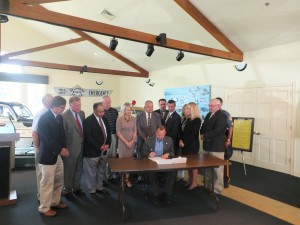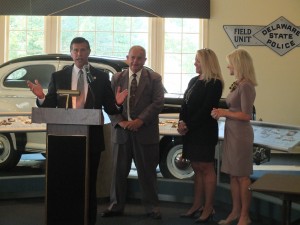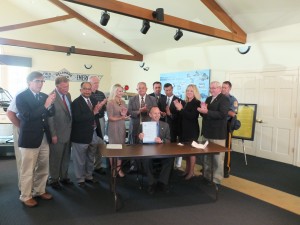NEW CASTLE (August 29, 2013) –With today’s grand opening of ReCommunity’s 35th Materials Recovery Facility (MRF), the largest pure-play recycling company in the United States launches into a 20-year agreement with the Delaware Solid Waste Authority (DSWA) to operate a state-of-the-art automated recycling facility that will serve Delaware statewide.
“Recycling is important to Delaware’s economy and environment,” said Governor Jack Markell. “ReCommunity’s investment and their technological innovation perfectly align with statewide universal recycling programs with the goal of turning ‘waste streams’ into economic opportunities for Delaware by ensuring material and resource recovery. We also welcome ReCommunity’s commitment to the state’s recycling requirements – reflecting the company’s recycling leadership in the 21st century.”
ReCommunity invested $15 million to repurpose the existing 64,000 square foot facility, also installing state-of-the art sorting equipment within the Delaware Recycling Center (DRC) to process recyclable aluminum, plastics, paper, cardboard, tin and glass collected from throughout Delaware.
“When DSWA reviewed the proposals for green industries at the DRC, it was clear ReCommunity is a leader in the recycling industry,” said Pat Canzano DSWA CEO. “But what was most impressive about them is their commitment to Delaware and the surrounding community.”
DSWA previously assembled the recyclable materials collected in the state at one of two transfer stations and then transported the material to ReCommunity’s MRFs located in Pennsylvania and New Jersey, as well as other MRFs in the surrounding area. The retrofitted facility now keeps the recycling in state, immediately creating more than 35 new jobs in Delaware, which will hopefully increase to more than 70 jobs over time.
“ReCommunity exists to help our community partners extract value from their own resources,” said James Devlin, ReCommunity’s Chief Executive Officer. “Delaware is another shining example of our commitment to ‘Leading the Recovery RevolutionTM’ within forward-thinking communities seeking significant positive gains.”
The world-class operation and design showcased within the ReCommunity Delaware facility includes advanced automated sorting capabilities that allow identification, separation and recovery of recyclables.
The BHS-installed equipment includes screening, optical sorting, air and controls technology to recover more than 90 percent of available recyclables. The state-of-the-art facility can process more than 35 tons per hour, with the capacity to handle more than 160,000 tons per year.
At full capacity, ReCommunity Delaware will recover material that will prevent 464,331 metric tons of carbon dioxide-equivalent greenhouse gases from being emitted annually, which is equivalent to removing 85,045 cars from the road each year. It will also save 218,587 cubic yards of landfill space and avoid 1,806,539 gallons of wastewater from entering landfills.
“Delaware is rapidly emerging as a national leader in recycling, demonstrating that environmental stewardship and economic prosperity can go hand-in-hand,” said Collin O’Mara, Secretary of Department of Natural Resources and Environmental Control. “Through this state-of-the-art facility, DSWA and ReCommunity will reduce material going to landfills, create well-paying jobs, and support new market opportunities for entrepreneurs.”
To celebrate the opening of ReCommunity’s MRF and DSWA’s new Environmental Education Building, DSWA and ReCommunity will host a community Open House event from 10 a.m. to 3 p.m. Saturday, September 7 at 1101 Lambsons Lane in New Castle. Families can tour the new ReCommunity MRF and see how recyclables are sorted and processed, as well as view interactive exhibits on recycling, waste collection and landfills on display at DSWA’s Environmental Education Building. In addition, DSWA is holding a collection event of household hazardous waste, paper for shredding and electronic equipment for recycling. For more information on the Open House and collection event, visit DSWA’s website, www.dswa.com.
Vol. 43, No. 336 -30-
About ReCommunity
ReCommunity, headquartered in Charlotte, N.C., is a leading recycling and recovery company that is focused on dramatically reducing the volume of landfilled waste. The company aims to lead a Recovery RevolutionTM by repositioning waste as a strategic community resource instead of a growing liability. With 35 facilities in 13 states, ReCommunity enables community partners to create additional revenue, create new jobs, and create a better future. For more information, visit www.ReCommunity.com.


